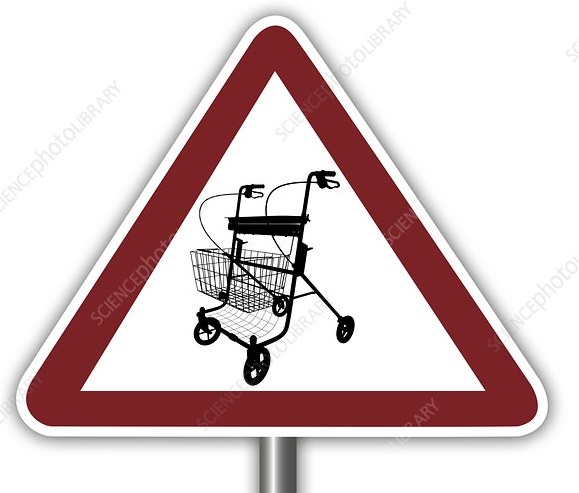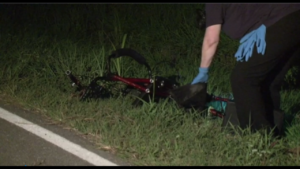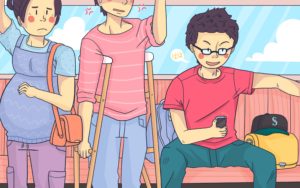
Things My Walker Taught Me
When I was growing up back in the ’70’s, kids were taught manners and respect for our elders. We were taught to hold doors open for adults, especially seniors and those using mobility aids like canes or wheelchairs. We were taught to call adults we didn’t know “Sir” or “Ma’am”. We were taught to do what adults told us to do, even if they weren’t our parents. We were taught to say “Please” and “Thank you”. We were taught to be aware of our surroundings, to watch where we were going, and to get out of other peoples’ way when needed. We were taught to respect others, and in the process learn respect for ourselves.
We now live in the cellphone age. Cellphones have taught people to be selfish, disrespectful and oblivious. They’ve imparted a “me first, get out of my way” attitude. Cellphone users (or zombies as I call them) expect to be able to keep their noses buried in their screens no matter what’s going on around them.
So what do cellphones have to do with the way people treat the disabled? The entitled, self-absorbed attitude they impart prevails even when a person is not buried in a cellphone screen. The many negative effects of cellphones on humanity are discussed in a separate entry. They spill over to other aspects of life, including the dehumanizing way people treat each other, and and not noticing the disabled, much less being willing to accommodate our needs.
I got my first rude awakening when I was trying to cross the street I live on for the first time using my walker, to get to the bus stop which is directly across the street from my apartment building. I’ve crossed that street literally millions of times since I moved into my building back in 2005. The stop is located on a winding four lane street, in the exact centre between two intersections. It’s surrounded by condos and apartment buildings so a lot of people use the stop and cross at that point. It’s about a 10 minute walk to either of the two intersections. Everyone just jaywalks to get to that bus stop. If someone’s crossing and a car comes around the curve of the street, the car either slows down or moves to the other lane.
This time, I was nearly across (about 2 feet from the curb on the opposite side) when an SUV came hurtling around the curve. The woman behind the wheel immediately began leaning on her horn. Not just honking or tooting it, leaning on the horn in a long blast. She then pulled up and stopped with her front bumper less than a foot away from me, lowered her window and began screaming obscenities at me, heavily laced with “bitch”, still leaning on her horn. Nothing was stopping her from driving around me in the other lane. I had already lifted my walker over the curb and was off the street on the grass, out of her way. She sat there for another two minutes still screaming obscenities and giving me the finger before stomping on her gas pedal and taking off with screeching tires. At no time was I blocking her from proceeding on her way.
I chalked it up as one isolated incident involving an obnoxious person – until a few days later when I went out to run some errands on foot. Almost every time I crossed a street, on a crosswalk and on a green light, some vehicle or other objected to my presence on the crosswalk and would blast their horn, shout obscenities, or roll their vehicle forward until the front bumper was almost touching me, in an effort to bully me out of the crosswalk. Now, I may use a walker but I use it at a brisk adult walking pace. I don’t go any slower than someone without a walker. I never try to cross at the last minute before the light changes. But, just the sight of my walker seems to cause certain drivers to fly into a rage. I am guessing they expect me to be slow and delay them on their all-important journey by 15 seconds or so. They look at me and they see a walker, not a person. So it’s ok for them to behave obnoxiously, lean on their horns and bully me.

Another place where surprisingly obnoxious behaviour occurs is public transit. Most transit agencies have designated seating for the disabled, but it’s designated, not reserved. My city’s transit agency, the Toronto Transit Commission (TTC) has pathetic, contradictory guidelines for disabled seating, at one point they state that if non-disabled passengers refuse to give up their seat the disabled person can ask the driver to intervene and the non-disabled person will be fined. Then in two other parts of the same policy, they state that drivers will not intervene. And how is a disabled person supposed to report someone who won’t give up a seat? It’s not like that person will willingly give their name and address so they can be fined. Instead the Toronto Transit Commission, like other transit agencies the world over, does nothing but pay lip service to accessibility by putting blue upholstery and stickers on “priority” seating, then fail to enforce it because there are no laws forcing them to. This needs to change. In the UK a man in a wheelchair who was denied the use of the designated wheelchair space on a bus in favour of a woman with a stroller has sued in Supreme Court for the right of the disabled to be given first priority for seating over the non-disabled, and for that priority to be enforced by drivers and other transit agency staff. But in the meantime transit agencies like TTC continue to claim to accommodate the disabled while in practice hiding behind a “first come first served” policy and allowing non-disabled patrons to continue monopolizing infrastructure for the disabled.
The result is that the selfish, entitled and oblivious passengers take full advantage of this lack of enforcement. They’re too lazy to move to the back of the bus where there are plenty of empty seats. Some feel entitled to use the seats, particularly able bodied seniors and youths. I also notice certain ethnicities are more selfish, especially the Chinese of all ages. Chinese seem to think that because they’re carrying a few grocery bags this entitles them to monopolize three disabled seats – one for themselves and the other two for their belongings. Or, they bring outrageously large shopping buggies on the bus, park themselves just inside the front door, and refuse to move when others try to get on or off of the bus. Speaking of outrageously large, there are also the gigantic oversized SUV strollers to contend with. They completely block the aisle, along with at least three disabled seats, and the parents almost invariably park them immediately behind the driver instead of moving further back. Due to the monstrous size of these strollers, all the time I see parents pushing children as old as elementary school age in them. It’s high time the transit agencies started imposing size limits on strollers and shopping carts on transit vehicles, because in the event of an accident nobody would be able to use the front door of the vehicle. instead, drivers will even kick a disabled person off of the bus to make room for stroller users.

So, when I get on the bus with my walker, I pay my fare and turn to sit. If a stroller or large shopping buggy is blocking the aisle I’m forced to get off the bus and wait for the next one. Invariably all of the disabled seats are taken, even if the rest of the bus is empty. The faces of those in the disabled seats when they see me are comical. They look down, away, out the window, anywhere but at me. Others look right at me, belligerently. Only the occasional passenger will actually move out of the way and find another seat. I always make a point of thanking those who move or who do anything to help me (I was raised in the seventies, remember?). There are usually feet, canes, grocery bags, shopping buggies, and other items in the aisle. None get moved out of my path unless I ask, and even then most of them turn their faces away and ignore me, then I have to climb and stumble over the obstacles as best I can while the bus lurches into motion. I’ve fallen over objects in the aisle several times.
Getting off the bus is even more fun than getting on. Not only do I have to worry about those bags, buggies, canes etc., but people like to loiter in the narrow front aisle beside the driver, and they’re very protective of that spot for some reason. They’ll block that aisle even when the seats are all empty. And it’s not because they’re about to get off the bus. The trouble is, there simply isn’t enough room for the loiterer and my walker, and I do not have the option of exiting by the rear doors because they’re too high and too far from the curb. I will politely let them know two or three stops ahead of my stop that I’ll be getting off the bus in [x] number of stops, could they please move so I can get off? Not once have they moved. The bus driver refuses to get involved. So one of two things happens: I fall and get hurt trying to climb around them on a moving bus with a walker, or I miss my stop. Or both. As I write this I’m still nursing healing bruises from falling flat on my side while trying to climb over a loiterer’s belongings to get off of the bus. I lay there on the floor having trouble getting up, while the bus driver and the loiterer just looked at me in disgust. Neither offered to help. I was covered in black bruises from my shoulder down to my hip. As a result I will be applying for the disabled transit service, where they send a special truck to my door and drop me off at my destination for the price of a regular fare. Enough is enough.
In general, as with the disabled seats on the bus, a big obstacle for the disabled is the misuse of disabled infrastructure by the non-disabled. If I have to be somewhere at a certain time I’ve learned to give myself at least half an hour of extra travel time, not because I move slowly (I walk faster than most people on my walker now) but because I have to make so many detours, and wait extra time to use things like elevators and ramps. Elevators meant for the disabled are monopolized by youths, or older but able bodied people who could use an escalator. Such elevators tend to be slower than normal ones, so if an elevator is full of able bodied people I have to wait 5-10 minutes for the next one – if it’s not being misused also. Wheelchair ramps are favourite haunts for youths, skateboarders, and texters. Asking people to move so I can use the ramp falls on deaf and resentful ears. Even the automatic door openers get misused by the selfish and impatient. I press the button to open a door, and before I can get to the door, rude people either come around from behind me and climb over my walker to get through the door first, or they barge in from the opposite direction and once again I’m forced to wait for them.
I’d say the worst part of being visibly disabled is being treated like I’m nothing. One day I had been out shopping and was at the bus stop to go home. I checked my transit app on my phone and the next bus wasn’t due for 20 minutes. It was a cold and blustery fall day and there was no shelter at that stop. So, I decided to go to a nearby McDonald’s to grab a coffee. I had never been to this McDonald’s. When I entered I saw a few people standing waiting for their orders. There was nobody at the cash register. I asked a lady who was waiting where to order, she was friendly and we exchanged a few pleasantries before she directed me to wait at the register. I waited about a foot away from the counter for someone to come and take my order. Then I saw a movement in the corner of my eye. A woman had entered the restaurant. She was well dressed in a fancy leather coat. She marched right past me to the register just as the staff arrived. I started to say “I was here first!” but both the cashier and the woman ignored me. I heard the lady I’d spoken with before say in outage “What just happened there?!? They just ignored you!” I sighed and told her “happens all the time”. I left without the coffee. It happened in Costco once, a man literally rammed me aside with his shopping cart and went around me in the exit line where they check your merchandise. I’ve also had people walk right around me and shove me aside to get to self-scan checkouts. Or they throw my receipt in my face and start ringing in their purchases when I haven’t packed mine yet.
While all of the above sound bad, in the end they are just inconveniences. At least when people can see I’m disabled, some of them are helpful or at least tolerant of having to deal with me and my walker. At least I can talk openly about having a sore back or bad knees or lack of balance caused by physical ailments. There’s no shame in using a mobility device, and people may be inconsiderate or rude but most don’t think any less of you as a person.
What about an invisible disability? The invisibly disabled are far worse off than I am, because there’s no way an able bodied person will give up a seat to someone who “doesn’t look disabled” in most cases. In Toronto there’s a campaign for the invisibly disabled to wear buttons identifying them as disabled, but many would be uncomfortable announcing their disability to the world on a button. The same issue exists for the invisibly disabled when they park in handicap designated spots, they are publicly shamed and falsely reported for fraudulent use of handicap stickers and parking spots.
I never tell anyone about my own invisible disability, bipolar disorder. Not on social media. Not in person. I don’t know how they will react, but I do know it won’t be positive. My entire family disowned me when they found out about my diagnosis. My government offers a tax credit for the disabled – but the criteria are written specifically to exclude the mentally ill. So far, this blog is the only place I’ve discussed my own illness.
If I were given the ability to choose between my painful physical ailments and the pain of bipolar disorder, I know which pain I would choose.

